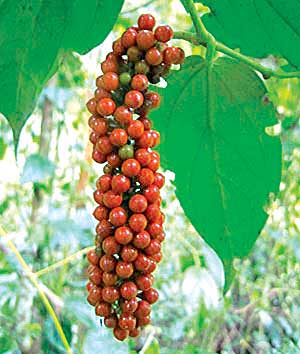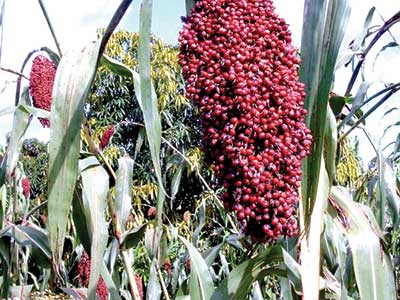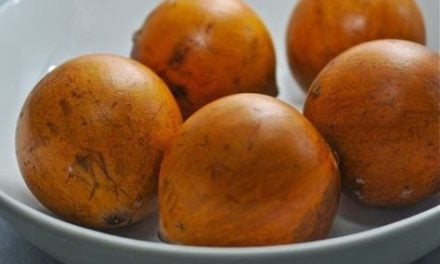 |
| Piper guineense is commonly called West African Black Pepper or Ashanti pepper (Uziza in Igbo and Ata iyere in Yoruba). |
By Chukwuma Muanya and Tayo Oredola
Before now, Sickle Cell Disease (SCD) persons were seen in some communities of the country as spiritually afflicted persons and were given names such as Abiku and Ogbanje among the Yorubas and Igbos respectively.
Currently, the level of technology has made it easy for SCD persons to manage the disease well, but the fact still remains that living with this genetic blood disorder in this part of the world largely comes with lots of challenges including stigma.
Omolara Eyinade, a 27-year-old sickle cell person recently told The Guardian in an interview in Lagos that “When you living with SCD in this part of the world, you are made to believe you feeble and cannot be productive as the so called ‘normal people’ so to say.”
According to Eyinade, growing with the disease was not really easy both for her and her parents, because “since it is a life long thing, it is expensive managing and getting care for it.”
“Living in that capacity, you learn to live with pains as well as endure as much of it as you can, especially during crises, because sometimes the pains gets severe even medications do not help it,” she said.
The 27 year old who lost her immediate younger brother to SCD last year said, “Living with the disease could be very stressful; I feel sad and depressed most of the time because in as much as I try to live a normal life, there are automatic barriers.”
Asked on how frequent she experiences crises, Eyinade explained, “I still experience crises from time to time, especially when I over stress my self, and trust me its an experience I do not wish for a loved one.”
She further noted, “Crises in SCD is seen as the hallmark of the disease, and if am to describe my experience of it, it feels like being hit consistently at the same spot with a hammer.” Is not fun being sick especially when you have to go through such indescribable pains, she added.
Eyinade, who is also a graduate of Journalism, told our correspondent, “Ever since I lost my brother who was 24 years old and a girlfriend suddenly to SCD four months ago, my experience of the slightest crises pops up the question, am I going to die to? In my mind.”
She lamented, “that experience has changed my life and I think I have learnt to live each day as it comes and as if it were the last, not knowing what would happen next.”
On how she manages the disease, she explained, “though I have been on daily medications, not all persons can afford, and naturally, my mother brought us up teaching us how to manage it with natural things like Ugu (pumpkin) leaves, taking ginger and garlic, eating balanced diets, and fruits with lots of vegetables and keeping warm when is cold.
Wikipedia defines SCD as a hereditary blood disorder, caused by an abnormality in the oxygen-carrying protein haemoglobin found in the red blood cells. This abnormal haemoglobin unlike the normal ones are sickle in shape, therefore making it not flexible and can stick to vessel walls, causing a blockage that slows or stops the flow of blood. When this happens, oxygen can’t reach nearby tissues, which typically manifests as acute or chronic pain especially in the bones and joints.
The acute pain, which is more common, can be severe and last from hours to days, and this painful period is referred to as ‘crises’, which is the hallmark of the genetic disease.
SCD is associated with other physical complications, including anaemia, jaundice, infections, stroke, gallstones, and kidney disease among others.
 |
| Eugenia caryophyllum (cloves) |
The predominantly black hereditary disease has no cure and according to the Sickle Cell Foundation, Nigeria, it is estimated that over 150,000 babies are born with symptomatic sickle cell anaemia each year in the country.
Making Nigeria record the highest prevalence of SCD in the world with 40 million Nigerians carrying the genes as well causing an annual infant death of 100,000, which represents eight per cent of infant mortality in the country.
Meanwhile, a lot of botanicals have shown promise in treating sickle cell anaemia. Top on the list is a combination of local herbs that has not been recognized globally even by the World Health Organisation (WHO) and the United States Food and Drug Administration (FDA) to be effective in reversing the sickling activities of the red blood cell.
Piper guineense, Pterocarpus osun, Eugenia caryophyllata, and Sorghum bicolor extracts have received United States Patent- US 5800819 A- for treating sickle cell disease.
The herbal combination developed by the Nigerian Institute for Pharmaceutical Research and Development (NIPRD) is called Niprisan- also called Nicosan.
The Patent noted: “A phytochemical composition for treating sickle cell disease is provided. The composition is a cold-water extraction product of a mixture containing Piper guineense seeds, Pterocarpus osum stem, Eugenia caryophyllum (cloves) fruit, Sorghum bicolor (guinea corn or sweet sorghum) leaves and potash. Also described are mixtures of phyto-materials used for preparing the extraction product, methods for making the extraction product, and methods for using the extraction product.”
Piper guineense is commonly called West African Black Pepper or Ashanti pepper (Uziza in Igbo and Ata iyere in Yoruba).Sorghum bicolor belongs to the plant family Poaceae. It makes a refreshing non-alcoholic beverage, kunu-zaki (in Hausa), and tasty pap, akamu (in Ibo), and thick porridge or porage, tuwo dawa (in Hausa). It is fermented to make sorghum beer called burkutu or pito, or made into flour and mixed with bean flour then fried to make dawaki.
A summary of the invention noted: “It is a primary objective of the present invention to provide a phytodrug that is useful in the care and management of sickle cell disease in persons afflicted with such disease. It is also an objective of the invention to provide methods for preparing a useful phytodrug and for treating persons afflicted with sickle cell disease.”
Eremomastax polysperma posses sickling inhibition potential reduced bad cholesterol
A study published in European Journal of Biology and Medical Science Research concluded: “Antisickling, serum lipids and protein estimation following administration of ethanolic extract of Eremomastax polysperma was performed using standard methods.
“The results obtained revealed that the extract possessed sickling inhibition potentials and also reduced the relative composition of bad to good cholesterol. More so, the non-significant reduction in serum total protein and albumin could infer that the extract is not hepatotoxic. However, more holistic toxicity studies need to be performed in order to certify that this extract is safe.”
The study is titled “Antisickling Activity of Eremomastax polysperma and Its Effects on Serum Lipid and Protein Profiles of Albino Wistar Rats.”
The leaf extract is used for the treatment of male infertility among the Ifa Nkari People of Akwa Ibom State, Nigeria (where it is known commonly as golden seal, African blood tonic plant and locally called, Edem Ididout, Ndana-edem).
The researchers from the Department of Biochemistry, Faculty of Basic Medical Sciences; and Department of Haematology, University of Uyo Teaching Hospital, Uyo, Akwa Ibom State, investigated the antisiskling serum lipid and protein profiles of ethanolic extract of Eremomastax polysperma using standard experimental procedures.
The result obtained revealed that the extract effectively inhibited sickling in vitro. There was a persistent increase in anti-sickling potential of the extract on a time dependent manner, with the highest percentage sickling inhibition of 66.7 percent at the 180th minutes. This was significantly higher than 36.0 per cent obtained with the group administered with vehicle.
Similarly, the extract affected the serum total cholesterol and triacylglycerol significantly when compared with the control group. Also, the serum low density lipoprotein- ‘bad’ cholesterol (LDL-cholesterol) was significantly lower in the extract test groups. This aided the reduction of the ratio of bad to good cholesterol as typified by the lower ratio of LDL/High Density Lipo-protein- ‘good’ cholesterol (HDL)-cholesterol in the experimental tested group than the control. Though the total protein levels of the tested groups were lower than those in the control group, this reduction was not significant to extent of assuming toxicity at the tested doses.
Pawpaw and guinea corn
Nigerian researchers have achieved 93 per cent anti-sickling properties and 84 per cent reversal activities with Carica papaya (pawpaw) and Sorgum bicolor extract. Sorghum bicolor is commonly called guinea-corn or sweet sorghum. Guinea corn is called dawa in Hausa.
The study was published in African Journal of Pharmacy and Pharmacology by researchers from Adekunle Ajasin University, Akungba-Akoko, Ondo State and Obafemi Awolowo University, Ile-Ife, Osun-State.
Traditionally in Nigeria, S. bicolor is used as a blood builder and used in the treatment of sickle cell crisis. A four – five day cold infusion of a mixture of S. bicolor leaves and Carica papaya unripe fruit pulp is used by the Yorubas (western Nigeria) to alleviate bone pains.
The researchers wrote: “The anti-sickling properties of fermented mixture of dried unripe fruit pulp of Carica papaya and dried Sorghum bicolor leaves, mixed in equal proportions in distilled water, was carried out using sodium metabisulphite sickled red blood cells and the result presented. Equal weight of dried C. papaya fruit pulp and S. bicolor leaves were fermented together in distilled water at room temperature and the aqueous extract obtained and used for anti-sickling assays.
“The extract gotten from the materials incubated for five days indicated as SP5, was found to have the highest anti-sickling properties with 93 per cent inhibitory and 84 per cent reversal activities. The concentration of the day-five extract was further varied. 0.2 ml was found to be the optimum volume of the test extracts…
“C. papaya had been reported to possess anti-sickling properties suggesting that the active compound(s) preventing and reversing sickling could be organic acids, produced after hydrolysis of corresponding esters in the fruit. Also reported are amino acids, glycine, phenylalanine and tyrosine, which have been reported to possess anti-sickling properties.
“The combination of these two plants could have synergistic effect since one or more components of each have anti-sickling properties hence the high values for both the reversal and inhibitory activities.”
A herbal preparation made with Sorghum bicolor has been able to boost blood levels (treat anemia), stop pain and inflammation, reverse cell damage (antioxidant), and increase cellular immunity in Persons Living With HIV/AIDS (PLWHA) in animal and human models.
Researchers have also shown that unripe mature pawpaw seeds may provide a cheap and accessible treatment for kidney damage and sickle cell anaemia. They found that seed extracts of unripe mature fruits of pawpaw can protect the kidneys from damage and could offer hope for the treatment of poison-related kidney (renal) diseases.
The study titled “Nephroprotective activities of the aqueous seed extract of Carica papaya in carbon tetrachloride induced renal injured Wistar rats: A dose- and time-dependent study,” was published in Biology and Medicine.
Nigerian researchers have also shown the anti-sickling properties of crude juice extracts of the edible portions of three commonly consumed tropical fruits namely Persia americana (avocado), Citrus sinensis (orange) and Carica papaya.
The study was published in African Journal of Traditional Complementary and Alternative Medicines.
Fagara zanthoxyloides and Cajanus cajan
Researchers have clearly demonstrated that plant-based antioxidants replete in Cajanus cajan (Pigeon pea in English, fio fio in Igbo), Fagara zanthoxyloides (Chewing stick in English, orin ata in Yoruba), fishes, fruits and vegetables, nuts and whole grains, and nutritional supplements can compensate for some inborn defect of sickle cell anaemia.
The studies suggest that for people with Sickle Cell Disorder (SCD), it means healthier red blood cells, less anaemia and pain, and other improvement in health.
Nigerian researchers have reported a randomised single-blind placebo controlled study, which showed that the extract of Cajanus cajan reduced the frequency of painful crises and possibly ameliorated the adverse effects of SCA on the liver in children aged one to15 years.
Cajanus cajan is a popular food in developing tropical countries and belongs to the plant family Fabaceae. Nutritious and wholesome, the green seeds (and pods) serve as vegetable.
The results of this study by researchers at the College of Medicine University of Lagos (CMUL)/Lagos University Teaching Hospital (LUTH), Idi-Araba, published in the Journal of Tropical Paediatrics, are encouraging when viewed in the light of increasing concern about the benefit of new conventional therapies like Hydroxyurea in an African setting where limited resources make widespread use, monitoring of side effects, and toxicities virtually impossible.
Considerable attention has thus been paid, particularly in Africa, to naturally occurring anti-sickling agents, which offer the potential of being relatively safer, easily administered and potentially less costly than Hydroxyurea.
In summary, evidence from this study shows that the extract of Cajanus cajan appears to be safe, easily administered and efficacious in reducing painful crises and may offer increased benefit to patients with SCA in future.
Roots of Fagara zanthoxyloides (orin ata in Yoruba), known as chewing sticks, are widely used for tooth cleaning in West Africa. The Nigerian Zanthoxylum is a common component of the rain forest vegetation of southern Nigeria.
Alchornea laxiflora
Alchornea laxiflora has shown promise in a College of Medicine University of Lagos (CMUL), Idi-Araba, study in treating sickle cell anaemia.
Alchornea laxifora is called uwenuwen in Edo; ububo in Igbo; urievwu in Urhobo; and ijin, ijin funfun and ijindi in Yoruba.
Preclinical anti-sickling and haemolytic toxicity studies on the herbal product, Cellod-S, carried out by researchers at Natural Medicine and Molecular Pharmaco-Biotechnology Laboratories Faculty of Pharmacy, CMUL, indicated that the herbal preparation produced 85 per cent sickling inhibition and 69.1 per cent sickling reversal.
The study titled “Does re-hydration necessarily imply re-oxygenation in sickling reversal? The Gardos phenomenon – revisited. A case for cellod-S herbal remedy” was published in Journal of Pharmaceutical Sciences and Pharmacy Practice.
The researchers concluded: “The results of these pre-clinical evaluations indicate that Cellod-S has the acclaimed anti-sickling ethnomedicinal use, and thatbhaemolysis – a major mechanism-based toxicity of potential anti-sickling agents, and phenomenon most guided against in sickle cell sufferers- is not a problem with Cellod-S. We therefore recommend Cellod-S for extensive clinical evaluations in humans.”
Indian almond
Nigerian researchers have also studied the anti-sickling activity of Terminalia catappa leaves harvested at different stages of growth.
According to the study published in the Nigerian Journal of Natural Products and Medicine, the aqueous and ethanolic leaf extracts of Terminalia catappa, a fruit bearing tree, popular in folkloric medicine for the treatment of sickle cell anaemia disease were assessed for their in-vitro anti-sickling activities. Extracts were prepared from the reddish-brown freshly fallen leaves, reddish-brown leaves and green leaves of the plant by maceration in the solvents.
Indian almond is botanically called Terminalia catappa and belongs to the plant family combretaceae. It is found in almost every town and village in southern Nigeria.
Studies have shown that diabetes and its attendant complications (erectile dysfunction/premature ejaculation, leg ulcer/gangrene, liver/ kidney failure), lung cancer and sickle cell anaemia can be addressed with extracts of Indian almond.
Source: The Guardian





